New HPLC Systems and Products Introduced at Pittcon 2015: A Brief Review
LCGC Europe
This instalment highlights some of the new HPLC systems, modules, accessories, and related technology introduced at Pittcon this year.
This instalment highlights noteworthy high performance liquid chromatography (HPLC) and related products introduced at Pittcon 2015 in New Orleans, Louisiana, USA, as well as in the year prior. It summarizes the technical aspects of new HPLC and supercritical fluid chromatography (SFC) systems, modules, software, and product extensions. The focus is on innovative products, major upgrades, and novel features with substantial user impact.
The Pittsburgh Conference on Analytical Chemistry and Applied Spectroscopy (Pittcon) is the world's largest conference on laboratory science. The 66th Pittcon was held this year at the Ernest N. Morial Convention Center in New Orleans, Louisiana, USA, from 8 to 12 March. Prior years that Pittcon was held in the same city were 1988, 2001, 2002, and 2008. New Orleans, Chicago, Illinois, and Orlando, Florida, are the three top locations for Pittcon, supplemented by venues in other cities such as Philadelphia, Pennsylvania, and Atlanta, Georgia (1). New Orleans is located on the bank of the Mississippi River and is famous for its Cajun cuisine, jazz and blues heritage, and the annual festivity of Mardi Gras. The subtropical climate at Pittcon this year contrasted greatly with the austere wintry temperatures of Pittcon 2014, which was held in Chicago.
Pittcon 2015 attracted 14,200+ attendees from more than 90 countries to attend more than 2000 technical presentations, ~150 short courses, and a huge exposition of analytical instruments. Once again, Pittcon 2015 provided a premier meeting place for analytical chemists and a global show case for instrument manufacturers.
Megatrends in HPLC Equipment
2015 has been a productive year so far for new high performance liquid chromatography (HPLC) and supercritical fluid chromatography (SFC) product introductions. A little more than 10 years after the commercial introduction of the first ultrahigh-pressure liquid chromatography (UHPLC) system in 2004 (2,3), second-generation UHPLC systems are steadily making their debuts. Following are a few of the megatrends in HPLC equipment:
- Improved second-generation UHPLC systems that offer higher operating pressure ratings, lower dispersion, innovative ovens or autosamplers, and faster cycle times (4–6).
- Many manufacturers offer a single instrument platform with multiple-tiered pressure ratings (Agilent 1290 versus 1260 or 1220) or configurations (modular versus integrated). Modular systems typically have higher system performance, while integrated systems generally have lower pricing for quality control applications (for example, Shimadzu Nexera X2 versus Nexera-i).
- New systems can be brand-new platforms (such as the JASCO LC-4000 and Thermo Vanquish) or upgraded versions of existing systems (for example, Agilent 1290 Infinity II). They can also be specialized application systems (for example, two-dimensional (2D)-LC, as exemplified by Shimadzu's Nexera-e system).
- While hardware specifications remain important, purchasing decisions continue to be dominated by considerations of the choice of the chromatography data system (CDS) (7).
SFC is emerging as a preferred technology for chiral separation and purification with an increasing number of manufacturers appearing in the marketplace (JASCO and Shimadzu). Table 1 lists prominent new product introductions (arranged alphabetically by vendor name) at Pittcon 2015 or during the prior year, followed by more-detailed descriptions and comments for each product.
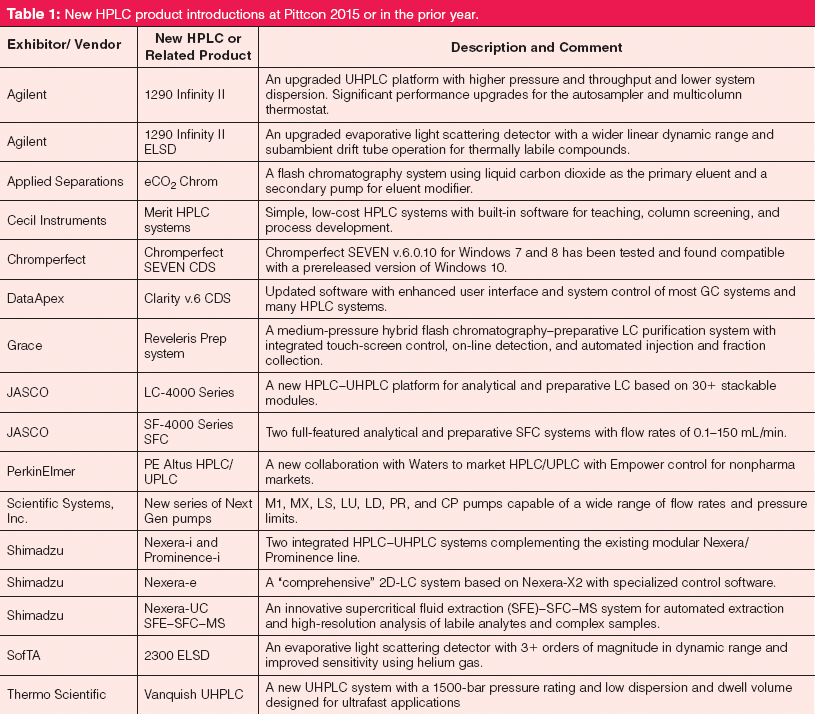
Table 1: New HPLC product introductions at Pittcon 2015 or in the prior year.
New HPLC and UHPLC Systems and Line Extensions
Several new HPLC and UHPLC systems or specialized applications systems and modules are summarized in Table 1 and are described with more details below:
Agilent 1290 Infinity II UHPLC - Five years after the introduction of the 1290 Infinity UHPLC, Agilent implemented a major upgrade to their flagship UHPLC system. All modules have a similar look and footprint (slightly wider for the column compartment) with significant performance enhancements for the autosampler and the column oven. The Agilent 1290 Infinity II has an upper pressure limit of 1300 bar with reduced system dispersion. Increased system throughput is accomplished with a new multisampler with an optional dual-needle design operating on two separate flow paths to reduce the cycle time to seconds. A higher sample capacity of up to 16 microtitre plates or 6144 samples (or 432 vials) is made possible by an integrated elevator plate feeder. Lower carryover (<9 ppm) can be achieved via external multisolvent wash to the outer needle and additional needle-seat backflush. The larger multicolumn thermostated compartment now fits up to eight short columns and accommodates column lengths of 30 cm with a temperature range of 4–110 °C. Two 1300-bar pumps are available: a high-speed (binary) pump and a flexible (quaternary) pump with improved compositional accuracy. A new diode-array detector has a higher sampling rate of 240 Hz and a smaller flow cell for improved efficiency with 2.1-mm i.d. columns. The Infinity II system uses Instrument Control Frame-work and RapidControl Drivers software to facilitate connection to any Agilent CDS (OpenLab or MassHunter) or other third party CDS. A new quick-connect fitting (fingertight up to 1300 bar) that autoadjusts tubing insertion length to eliminate void space is available.
Figure 1 shows the reduced cycle time of the Agilent 1290 Infinity II system using the double sampling needle option to eliminate time lags between injections.
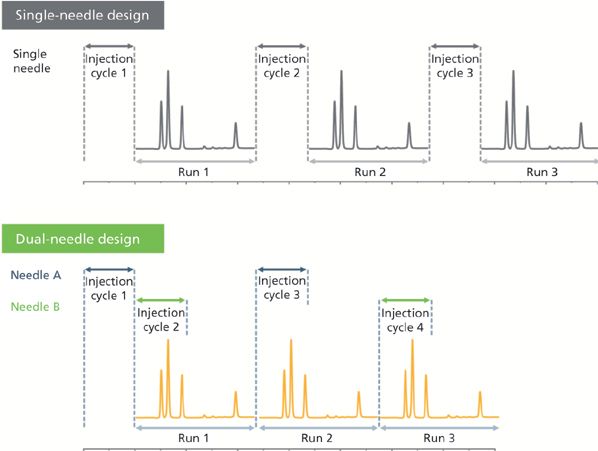
Figure 1: Two comparative signal traces of the reduced cycle time of the Agilent 1290 Infinity II system using the new Multisampler autosampler with a dual-needle design that eliminates time lags between injections.
Cecil Instruments' Merit HPLC systems - The Merit HPLC systems from Cecil Instruments are low-cost HPLC systems with built-in chromatography software and UV–vis or photodiode-array detection designed for teaching, quality control, column screening, and process development applications.
JASCO LC-4000 Series HPLC and UHPLC systems - The JASCO LC-4000 series is the latest LC platform consisting of many 300-mm wide, stackable modules. The modules can be configured into conventional (500 bar), rapid analysis HPLC (700 bar), UHPLC (1300 bar), or preparative LC systems (20, 50, or 120 mL/min). The LC-4000 replaces the existing JASCO series of X-LC-3000 or LC-2000 systems. All are controlled by the upgraded JASCO ChromNAV 2.0 CDS.
More than 30 new modules are available for analytical or preparative-scale applications with various specifications as follows:
- Autosampler: HPLC (300 bar, 60 vial), rapid HPLC (700 bar, 180 vial), UHPLC (1300 bar, 180 vial), and preparative scale (400 bar, 10-mL injection, 40 vials).
- Column ovens: Compact, high capacity (holds six or 10 columns), preparative (temperatures ranging from ambient -15 °C to 100 °C), and a reaction oven for postcolumn derivatization.
- Pumps: Four analytical pumps (binary or quaternary, 700 or 1300 bar) with dynamic or turbulent flow mixers and built-in microdegassers. Three preparative pumps have maximum flow rates of 20, 50, or 120 mL/min rated to 500 bar and have optional solvent degassing and recycling features.
- Detectors: Available UV–vis, photodiode-array, refractive index (analytical or preparative), fluorescence, circular dichroism, and optical rotation detectors.
- ChromNAV 2.0 CDS: Operates under Windows 7 or 8.1 with a graphical user interface and controls up to four JASCO systems. This CDS is 21 CFR Part 11 compliant. An optional ChromNAV-FC CDS is available for preparative LC and an optional ChromNAV-GPC add-on is used for molecular weight distribution calculations.
PerkinElmer Altus HPLC/UPLC - At Pittcon 2015, PerkinElmer launched its Altus HPLC and Altus UPLC systems, controlled through Waters Empower CDS, for the environmental, industrial, and applied markets.
Shimadzu Nexera-i and Prominence-i systems - Shimadzu introduced two identical looking integrated HPLC (Prominence-i) and UHPLC systems (Nexera-i) to complement their existing Prominence and Nexera XR/X2 modular systems. According to Shimadzu, the "i" in the i-series names stands for "integrated" (6) and also for "innovative", "intuitive", and "intelligent". These integrated units are designed for quality control and academic laboratories and are controlled by Shimadzu's LabSolutions and major third-party CDS. Each system is equipped with a built-in colour touch screen to allow control of all LC parameters, including automatic on/off, manual purging, batch table sequencing functions, and chromatogram display. System status (ready, pretreatment, run, and error) is readily visible from the front panel. One can start an analysis from the instrument's front panel immediately after loading samples. Remote monitoring via smart devices is possible.
The built-in autosampler can make reproducible injections down to less than 1 μL with a 14-s cycle time and can accommodate up to 216 1.5-mL vials. The large-capacity forced-air column oven fits six 10-cm or three 30-cm columns with a temperature range of ambient -10 °C to 85 °C. The built-in quaternary pump is rated at 440 bar (Prominence-i) or 660 bar (Nexera-i) and uses a parallel double plunger design. An optional low-pressure valve allows selection of up to seven solvent reservoirs. The built-in UV–vis or photodiode-array detector is equipped with TC-Optics and flow cell to reduce signal drift because of ambient temperature changes. Shimadzu's LabSolutions CDS allows many convenient autofunctions such as start-up, purging, column equilibration, baseline check, shutdown, system validation, and email notifications.
Shimadzu Nexera-e 2D-LC system - Shimadzu Nexera-e (the "e" stands for exponential) is a comprehensive 2D LC system based on the company's Nexera X2 UHPLC system. The system is designed for the analysis of complex samples by coupling two "orthogonal" separating modes with a built-in valve–loop switching system, and detection using photodiode-array or mass spectrometry systems (8). System configuration and setup is accomplished using LC×LC Assist software. Comprehensive 2D qualitative and quantitative analysis using contour graphics is accomplished via ChromSquare software, which can also display mass spectral data. Figure 2 shows a chromatogram of a first-dimensional separation of a complex traditional Chinese medicine sample and the resultant 2D contour display of more than 200 peaks displayed with ChromSquare software.

Figure 2: (a) Chromatogram in the first dimension of a separation of a complex traditional Chinese medicine sample with UV detection; (b) Resultant 2D contour display of more than 200 peaks with the ChromSquare software shown as spots in the 2D plot from "orthogonal" separations in the comprehensive 2D mode. Coeluting peaks from the first dimension (manifested as a peak shoulder in the inset of 2(a) are separated as distinct spots shown in 2(b).
Thermo Scientific Vanquish UHPLC system - The Thermo Scientific Vanquish UHPLC system is a new integrated, low-dispersion, biocompatible UHPLC system with an upper system pressure limit of 1500 bar or 22,500 psi (5). The Split Sampler HT is capable of precise injections of 0.01–100 μL. Its injection cycle time can be as short as 15 s, with carryover as low as 4 ppm. The sampler supports injections from HPLC vials as well as from 96- and 384-well plates. The optional charger unit extends sample capacity to 23 plates (8832 samples). Automated barcode reading for rack identification is available as an option. The unique column compartment H (5–120 °C) can operate in two thermostatting modes: a still-air mode to maximize column efficiency by reducing radial thermal gradients inside UHPLC columns or a forced-air mode to mimic column ovens of other manufacturers (9,10). The binary pump H has a unique dual-piston-in-parallel design with variable stroke volume capability. It has a flow accuracy of ±0.1% and pulsation of <0.4%. It supports binary high-pressure gradient mixing of six solvents (in a configuration of 2×3 and a total of nine combinations) with a default mixing volume of 25 μL. The built-in diode-array detector HL uses silica "LightPipe" technology, has a flow cell volume of 2 μL or 13 μL (pathlengths of 10 mm or 60 mm, respectively), and supports programmable slit widths of 1–8 nm spectral bandwidths. The system is controlled by the Chromeleon CDS with integrated mass spectrometry (MS) support.
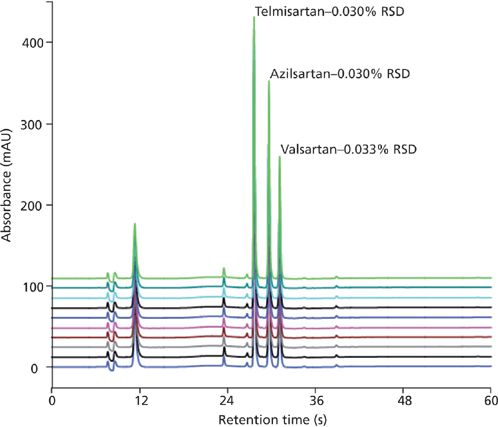
Figure 3: The excellent precision of the Vanquish UHPLC (peak area RSD of ~0.03%) in an overlaid chromatogram of 10 repetitive injections of a pharmaceutical sample containing three major drug components.
Figure 3 shows the excellent precision performance of the Vanquish UHPLC system with an overlaid chromatogram of 10 repetitive injections of a pharmaceutical sample. Figure 4 shows the simulated thermal heat maps inside an UHPLC column operating under a still-air mode (to maximize column efficiency) or a forced-air mode (to mimic operation in other manufacturers' ovens) (9,10).
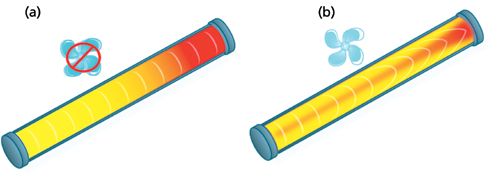
Figure 4: Simulated thermal heat maps inside an UHPLC column operating at very high pressure in a Thermo Scientific Vanquish UHPLC system: (a) Using the column oven operating under a still-air mode (with the fan off to maximize column efficiency without any radial thermal gradients); (b) using a forced-air mode with a circulating fan. Note that radial thermal gradients in the column under the forced-air mode can be highly detrimental to column efficiency performance.
HPLC Modules
Several new HPLC modules were introduced this year:
Agilent Infinity II ELSD - An upgraded evaporative light-scattering detection (ELSD) system with an improved linear dynamic range is capable of subambient drift tube operation for detection of thermally labile compounds.
SofTA 2300 ELSD - The upgraded 2300 ELSD system from SofTA has more than three orders of magnitude in dynamic range and an option of using helium nebulizer gas for improved sensitivity.
Scientific Systems Next Gen pumps - Scientific Systems, Inc. (SSI) introduced a new family of Next Gen pumps: M1, MX, LS, LU, LD, PR, and CP pumps capable of a wide range of flow rates (0.001–300 mL/min) and pressure limits (50–25,000 psi). The company's product line consists of pumps for analytical and preparative scales, flash, SFC, mini-metering, process, UHPLC, and biocompatible applications.
Chromatography Data Systems
A number of new updates in chromatography data systems were introduced this year:
Agilent OpenLab CDS - The improved OpenLab CDS software has a more intuitive user interface and faster time for data processing, reviewing, and reporting. It is 21 CFR 11 and European Union Annex 11 compliant and has a new graphical tool for sample entry for the new Infinity II Multisampler autosampler.
Chromperfect SEVEN CDS - Chromperfect SEVEN CDS v.6.0.10 for Windows 7 and 8 was found to be compatible to a prereleased version of Windows 10. Both Chromperfect SEVEN client-server and small laboratory (SL) CDS are 21 CFR part 11 compliant and can control most gas chromatography (GC) and many HPLC systems.
DataApex Clarity v.6 CDS - DataApex introduced an updated version of Clarity v.6 CDS with an enhanced user interface, sequence functions, GC×GC extension, and higher linearity ranges for MS and flame ionization detectors as well as system controls for Hitachi HPLC systems and Advion MS systems.
Preparative LC, SFC, and Other Related Products
Several new preparative LC, supercritical fluid chromatography (SFC), and other related products were also introduced this year, such as:
Grace Reveleris Prep system - The Grace Reveleris Prep is a medium-pressure (1700 psi), hybrid flash chromatography–preparative LC purification system, with integrated control software displayed on a 12-in. touch screen. It has a maximum flow rate of 200 mL/min with a built-in automated injector and fraction collector that uses three UV–vis plus evaporative light-scattering detector signals. This simple, yet flexible system is ideally suited for use in an organic synthesis or sample purification laboratory.
JASCO 4000 Series SFC - JASCO introduced five SF-4000 Series systems for semimicro, analytical, analytical or semipreparative, and semipreparative and preparative SFC. The systems have pumps capable of flow rates ranging from 0.2 mL/min to 150 mL/min at pressures up to 500 bar, variable loop injections of up to 180 samples, multiple column or solvent selection, detection by UV, circular dichroism, photodiode array, flame ionization, ELSD, and MS, and enclosed automated fraction collection.
Shimadzu Nexera-UC SFE–SFC system - The Shimadzu Nexera-UC (unified chromatography) SFE–SFC–MS system is an innovative on-line system designed for automated extraction and ultrafast analysis of a variety of analytes including labile compounds in complex samples (11,12). The automated Nexera SFE system can extract 48 samples (in 0.2- or 5-mL extraction vessels, at temperatures up to 80 °C, and pressures as high as 40 MPa) with subsequent on-line SFC analysis with MS and UV detection. The system is uniquely suited for analysis of difficult samples such as multiresidual pesticides and polycyclic aromatic hydrocarbons in foodstuffs or soil, labile lipids or disease biomarkers in biofluids or dried bloods, swabs for cleaning verification (12), and additives in organic polymers. The Nexera SFC system includes the LC-30AD pump (5 mL/min to 66 MPa) with a back-pressure control unit and can be configured for chiral screening (12 columns with four organic modifiers) or as an SFC-UV analytical system. The system's automated extraction, coupled with the direct splitless SFC–MS interface, leads to highly reproducible and sensitive assays of labile or water-sensitive analytes in complex sample matrices.
Figure 5 shows results from two applications of the SFE–SFC–MS system: automated analysis of a labile analyte (reduced coenzyme Q10 from a dietary supplement) and residual detergent analysis from a cleaning verification swab sample.
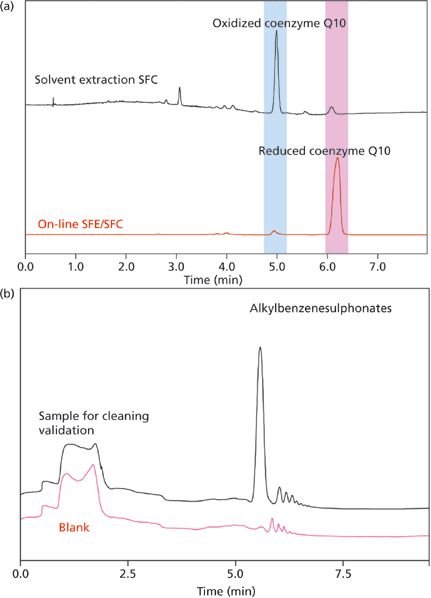
Figure 5: The results of two applications of the Nexera UC SFE–SFC–MS system: (a) An on-line SFE and SFC analysis of reduced coenzyme Q10 extracted from a dietary supplement shown in the bottom chromatogram is preferred over analysis using off-line extraction. (b) SFC chromatogram of residual detergents (alkyl benzenesulfonates) from a cleaning verification swab sample extracted directly from the swab with SFE versus a blank swab.
Applied Separations eCO2 Chrom - Applied Separations' eCO2 Chrom is a flash chromatograph using liquid (not supercritical) carbon dioxide as the primary eluent. A standard carbon dioxide cylinder provides the pressure to drive the system. A supplementary pump is used for delivering an eluent modifier (such as methanol). This purification system is equipped to use disposable and reusable columns, and comes with integrated software, a UV detector, and an automated fraction collector.
Concluding Remarks
Many analytical chemists, including myself, come to Pittcon for professional and personal reasons. My schedule this year (my 16th consecutive year) included several short courses on HPLC and UHPLC and the drug development process, attending the plenary lecture by Dr. Halas, and two of my own oral presentations and a poster on low-cost MS. My networking events included an LCGC editorial advisory board lunch meeting and the Chinese American Chromatography Association (CACA) dinner with ~100 attendees (featuring speeches by Professor Yafeng Guan of Dalian Institute and Dr. Richard Henry from Supelco). I spent two days on the exposition floor gathering confirmatory information for this instalment. The excellent organization of Pittcon allows me to learn about emerging analytical trends, meet with old colleagues, and make new acquaintances. I look forward to attending future Pittcon conferences to be held in Atlanta, Chicago, Orlando, Philadelphia, Chicago, and back to the "Big Easy" (New Orleans) in 2021.
Summary
This instalment summarizes new HPLC and SFC product introductions (systems, modules, CDS, software, and related products) launched at Pittcon 2015 and in the prior year. It focuses on innovative features from a user's perspective. Since the coverage is brief and nonexhaustive, the reader is referred to manufacturers for additional technical details. Note that new HPLC columns introduced at Pittcon are presented and discussed separately in LCGC's annual reviews (13). The opinions expressed in this instalment are the author's own and bear no reflections of those from LCGC, the Pittsburgh Conference, or any other organizations.
Acknowledgements
I would like to thank the Pittcon staff for organizing this global conference so predictably well, where everything runs like clockwork. Also, a special thanks to the marketing personnel of manufacturers for their timely responses to our requests for information. The author is particularly grateful to Drs. Davy Guillarme and Szabolcs Fekete of the University of Geneva, Mengling Wong from Genentech, Dr. Raphael Ornaf of Vertex Pharmaceuticals, and John Batts of IDEX Health & Science for their invaluable editorial and technical input.
Michael W. Dong is a senior scientist in Small Molecule Drug Discovery at Genentech in South San Francisco, California, USA. He is responsible for new technologies, automation, and supporting late-stage research projects in small molecule analytical chemistry and QC of small molecule pharmaceutical sciences. He holds a PhD in analytical chemistry from the City University of New York and a certificate in Biotechnology from U.C. Santa Cruz. He has more than 100 publications and a best-seller in chromatography. He is a member of the editorial advisory board of LCGC North America. Direct correspondence about this column should be e-mailed to the editor-in-chief, Alasdair Matheson, at amatheson@advanstar.com
References
(1) D.C. Brock, Chem. & Eng. News 87(8), 12–22 (2009).
(2) D. Guillarme and M.W. Dong, Amer. Pharm. Rev. 16(4), 36–43 (2013).
(3) D. Guillarme and M.W. Dong, Eds., UHPLC: Where We Are Ten Years After Its Commercial Introduction, Trends in Anal. Chem. 63, 1–188 (2014).
(4) S. Fekete, I. Kohler, S. Rudaz, and D. Guillarme, J. Pharm. Biomed. Anal. 87, 105–119 (2014).
(5) K. Broeckhoven and G. Desmet, Trend in Anal. Chem. 63, 65–75 (2014).
(6) M.W. Dong, Modern HPLC for Practicing Scientists, (Wiley, Hoboken, New Jersey, USA, 2006), Chapter 4.
(7) R.P. Mazzarese in Handbook of Pharmaceutical Analysis by HPLC, S. Ahuja and M.W. Dong, Eds. (Elsevier, Amsterdam, Holland, 2005), Chapter 20.
(8) D.R. Stoll, X. Li, X. Wang, P.W. Carr, S.E.G. Porter, and S.C. Rutan, J. Chromatogr. A. 1168(1–2), 3–43 (2007).
(9) F. Gritti and G. Guiochon, Anal. Chem.80, 5009–5020 (2008).
(10) M.W. Dong, LCGC Europe26(11), 637–645(2013).
(11) E.L. Regalado and C. Welch, Trends in Anal. Chem. 67, 74–81 (2015).
(12) T. Uchikata, A. Matsubara, E. Fukusaki, and T. Bamba, J Chromatogr A.1260, 69–75 (2012).
(13) M. Swartz, LCGC Europe28(4), 232–243 (2015).
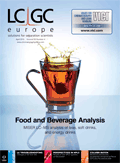
Study Examines Impact of Zwitterionic Liquid Structures on Volatile Carboxylic Acid Separation in GC
March 28th 2025Iowa State University researchers evaluated imidazolium-based ZILs with sulfonate and triflimide anions to understand the influence of ZILs’ chemical structures on polar analyte separation.